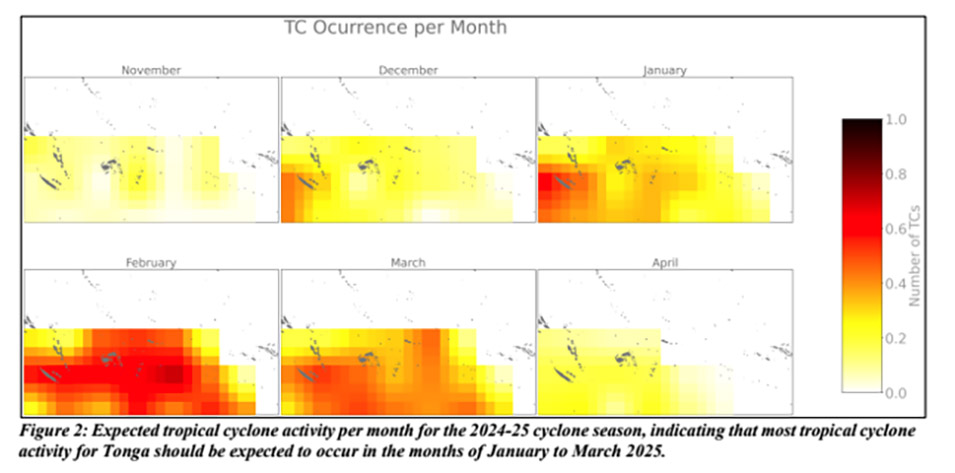
Tonga is expecting one to two cyclones with a moderate to high chance (>50%) of at least one severe tropical cyclone occurring, reports Tonga Met today, in its updated outlook for the 2024-2025 Tropical Cyclone Season. Based on the current modelling, the occurrence of tropical cyclones in Tonga is more likely to be from January to March with most events occurring in February.
“Historical records also indicate that Tonga could expect at least one cyclone and at most, three cyclones, to occur with a moderate to high chance (>50%) of at least one severe tropical cyclones occurring,” Tonga Met stated.
Tropical Cyclone Gita (Cat. 4) formed in 2018 when conditions were similar to the current and forecast conditions in the upcoming 2024/2025 TC season (Table 2- below).

The official 2024/2025 tropical cyclone season will begin on 1 November 2024, and end on 30 April, 2025.
However, Tonga Met noted that tropical cyclones have occasionally formed outside this period, like TC Keli, which affected Northern Tonga in June 1997.
Tropical cyclones affecting Tonga this season should expect to be mostly coming from the South-West and North-West quadrants (Fiji Area: 70%) and the rest from the East and North-East quadrants.
South West Pacific Region
Altogether, there are about five to six named tropical cyclones expected for the South West Pacific Region (Nadi Area of Responsibility from 160E to 120W and from the Equator to 25S) for the season, with one to two TC reaching severe intensity (category 3 to 5).
The tropical cyclones formation areas will be shifted to the warmer ocean temperatures in the Australia, Papua New Guinea and Solomon Island regions.
During every tropical cyclone season there are active periods in which potential for tropical cyclone formation is increased. These active periods come around every 30 to 60 days on average and lasts for a duration of about two to three weeks in our region. On average, there are about three active periods during the season for the Southwest Pacific region.
Current dynamics indicate that the first tropical cyclone activity for this season in the South West Pacific region (including Tonga) is most likely to occur around November to December 2024.
"These active period(s) will be updated during the course of the cyclone season to aid with preparedness."
Above average rainfall with possible flooding
Tonga Met noted when tropical cyclones are passing close to the country, associated active cloud with heavy rain bands may occasionally affect Tonga with marked rainfall and possible flooding, including sea flooding of low‐lying coastal areas.
This tropical cyclone season will also likely bring above average rainfall to all island divisions of Tonga during the cyclone season due to weak La Nina conditions projected to develop for the second half of this season (February-April 2025).
Meanwhile, in some island divisions, the average monthly rainfall can be doubled.
El Niño–Southern Oscillation
Sea surface analysis indicates that the El Niño–Southern Oscillation (ENSO) is currently at Neutral phase.
Oceanic and atmospheric forecasts for ENSO suggest a La Nina episode, of weak to moderate intensity, with a 60-70% chance of emerging by December 2024.
If La Nina conditions should develop, they are likely to persist through the second half of the season in February-April 2025.
Tonga Meteorology noted likely sector impacts during the 2024-2025 El Niño–Southern Oscillation season:
- Agriculture - Although there is average cyclone occurrence for Tonga this TC season, it is the cyclone season so strong wind events will happen from time to time and crops prone to wind damage like Banana, Papaya and Breadfruit will be affected. At the same time, La Nina conditions will bring above average rainfall which will good for planting higher rainfall (big leaf plants) crops such as Kava, Taro, Banana and Kape. Weed management will be a must this season in order to get a good harvest.
- Water - Water surplus during this season is to be expected for the second half of the TC Season. Therefore, rain water should be collected and harvested this season as much as possible to be used when the rainy season ends around April 2025. Clean roofs and replace guttering.
- Health - Higher risk of water contamination related diseases occurring due to events of above average rainfall expected and flooding of low-lying areas. Mosquitoes will be a problem from the months of December to February due to higher rainfall and higher humidity so mosquito management will be key to prevent mosquito transmitted disease like dengue.
- Infrastructure - There is a moderate to high chance of one severe cyclone happening this season, so the public are advised to fix shutters and trim trees near the house just in case we get a severe event.
- Tourism - Moderate to High risk for Tourism activities due to moderate to high chance of a severe cyclone occurring.
- Fisheries - Ocean nutrients will be abundant due to La Nina conditions so expect tuna fisheries to be good as well as trolleying. Expect low to moderate coral bleaching or algae blooms.
- Utilities - Moderate to high risk of Communications, Water and Power utilities failures due to tropical cyclone activity. But high risk of flooding related problems.
- Transport - Moderate to high risk of above than normal cancellations to ferry and aircraft operations due to stronger winds and tropical cyclone activity. Higher risk road and drainage flooding related problems due to higher expectation of above average rainfall.



